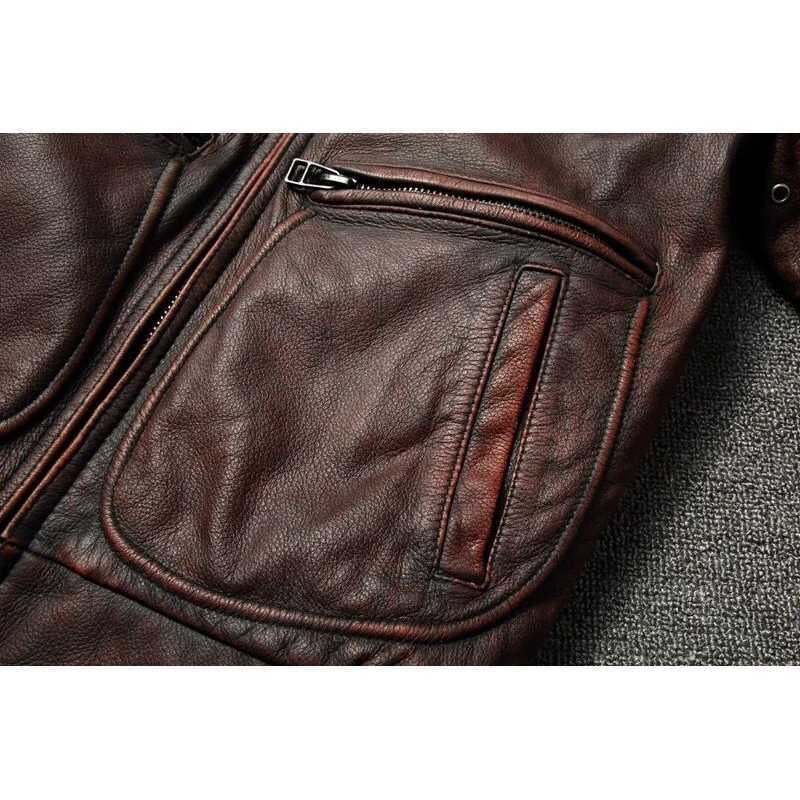Have you ever walked into a store, browsed online, or searched through marketplaces for a leather item—maybe a watch strap—and felt utterly confused by terms like "full-grain," "top-grain," or "genuine leather"? Trust me, you're not alone. Leather terminology can indeed be tricky. So, how can you really distinguish high-quality leather from cheaper materials when buying leather items, especially watch straps? Let's make it simple.
What Exactly is Leather Grade, and Why Does it Matter?
Simply put, leather grade refers to the quality and characteristics of the leather based on how it's processed. Leather grade significantly impacts the durability, appearance, comfort, and price of leather products, especially when considering items like handmade genuine leather straps. Here’s a quick breakdown of leather grades in easy-to-understand bullet points:
- Full-Grain Leather
- Characteristics: Highest quality, natural surface with imperfections intact.
- Durability: Excellent; ages beautifully, develops unique patina.
- Best Used For: High-quality accessories, durable goods.
- Price Indication: Luxury.
- Top-Grain Leather
- Characteristics: Slightly sanded, even finish, fewer imperfections.
- Durability: Very good; ages well but lacks full-grain depth.
- Best Used For: High-end leather goods, quality watch straps.
- Price Indication: Premium.
- Genuine Leather
- Characteristics: Lower grade, layered or bonded leather, processed.
- Durability: Moderate; may crack or deteriorate faster.
- Best Used For: Affordable watch straps, temporary usage items.
- Price Indication: Standard to Affordable.
- Bonded Leather
- Characteristics: Made from leather scraps, bonded with glue.
- Durability: Poor; prone to peeling or splitting quickly.
- Best Used For: Very inexpensive items, temporary products.
- Price Indication: Cheap.
Understanding these grades helps you identify value and avoid costly mistakes. Remember, a beautiful vintage Seiko deserves a genuine leather strap for Seiko vintage watches that matches its elegance.
What Types of Animal Leather are Commonly Used in Watch Straps?
Not all leather is the same. Different animals provide distinct textures, strengths, and aesthetic appeal. When browsing classic leather straps for vintage watches, knowing these varieties can be invaluable:
- Cowhide Leather
- Look and Feel: Strong, durable, versatile texture, smooth surface.
- Commonly Used For: Everyday wear, casual and formal watches.
- Price Indication: Affordable to Premium.
- Crazy Horse Leather
- Look and Feel: Waxed, rugged, and vintage-looking appearance.
- Commonly Used For: Rustic style, vintage aesthetics.
- Price Indication: Standard to Premium.
- Snake Leather
- Look and Feel: Unique, exotic texture, elegant, smooth, delicate.
- Commonly Used For: Dressy, formal watches, luxury items.
- Price Indication: Premium to Luxury.
- Crocodile Leather
- Look and Feel: Luxurious, distinctive scales, durable.
- Commonly Used For: High-end, luxury watches.
- Price Indication: Luxury.
- Lizard Leather
- Look and Feel: Fine scales, delicate texture, sophisticated.
- Commonly Used For: Formal, elegant watch straps.
- Price Indication: Premium to Luxury.
Knowing the animal source can significantly impact your buying decision, especially for refined, high-end vintage watches or even stylish cheap old money watches.
How to Decode Leather Marketing Terms When Shopping?
Leather products often use misleading terms, so it's crucial to decode these cleverly marketed descriptions. Here's how to interpret common marketing terminologies:
- "Genuine Leather"
- Reality: Usually refers to lower-grade, affordable leather.
- What to Expect: Moderate quality, suitable for casual or temporary use.
- Price Indication: Affordable.
- "Real Leather"
- Reality: Can range widely; not specific to any grade.
- What to Expect: Ambiguous; confirm actual grade or quality.
- Price Indication: Affordable to Premium.
- "100% Leather"
- Reality: Real leather, but grade not specified—check carefully.
- What to Expect: Typically mid-quality; inspect texture and feel closely.
- Price Indication: Standard.
- "Bonded Leather"
- Reality: Leather fragments bonded together; lowest quality.
- What to Expect: Very short lifespan, not durable.
- Price Indication: Cheap.
- "Premium Leather"
- Reality: Marketing term; could mean top-grain or full-grain—always verify.
- What to Expect: Usually good quality; confirm with seller.
- Price Indication: Premium.
Understanding these terminologies ensures you're not overspending or unknowingly purchasing lower-quality leather. Whether you're exploring small wrist leather straps or sophisticated luxury straps, clear comprehension of these terms helps greatly.
Tips to Choose Leather Watch Straps Like an Expert
When choosing a watch strap, be mindful of the following:
- Examine the Edges
- Good straps have burnished, sealed edges, increasing longevity.
- Feel the Texture
- Authentic, high-quality leather feels supple, soft, and luxurious. Avoid overly stiff or synthetic-feeling straps.
- Check the Stitching
- Even, consistent stitching indicates quality craftsmanship. Avoid irregular or loose stitches.
- Inspect Hardware Closely
- Premium leather straps feature sturdy hardware like stainless steel or brass, enhancing the watch's durability and appearance.
- Smell the Leather
- Real, quality leather possesses a natural, earthy fragrance. Chemical odors suggest artificial treatments or low-quality leather.
Where Should You Buy Quality Leather Watch Straps and Vintage Watches?
Choosing where to buy is equally vital. For high-quality items like watch straps and vintage watches, reputable sources make all the difference. If you're pondering where to buy second hand watches, look for:
- Detailed product descriptions clearly indicating leather type and grade.
- Transparent vendor communication about sourcing and craftsmanship.
- Positive customer reviews validating product quality and service reliability.
Websites like Garasi Opung provide carefully curated selections, including vintage watches and authentic handmade genuine leather straps, ensuring every purchase is trustworthy.
Final Thoughts: Is Paying for Premium Leather Really Worth It?
In leather goods—especially watch straps—you genuinely get what you pay for. Investing a bit more upfront ensures comfort, aesthetics, and durability. While inexpensive, low-grade leather might initially appeal to your wallet, the short lifespan and poor quality usually mean you'll spend more in the long run. Ultimately, investing in well-crafted leather items enriches your experience, enhances your style, and respects the craftsmanship involved. Choose wisely, understanding leather grades, animal sources, and marketing terminology, and you'll confidently select pieces worth every penny, reflecting your personal style and standards.

